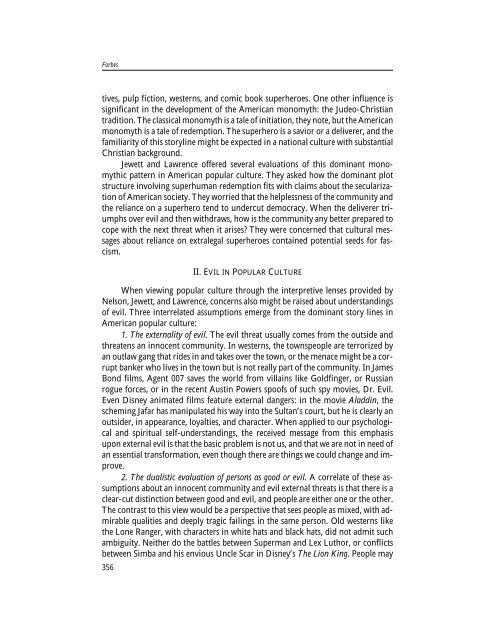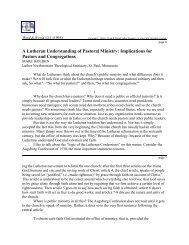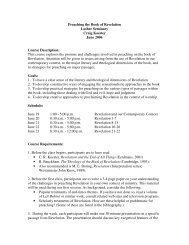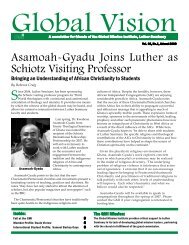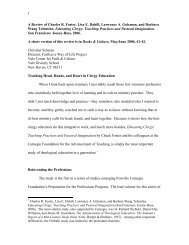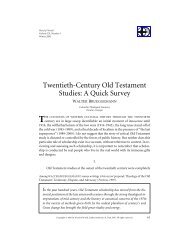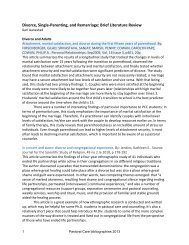Download Article PDF - Word & World - Luther Seminary
Download Article PDF - Word & World - Luther Seminary
Download Article PDF - Word & World - Luther Seminary
You also want an ePaper? Increase the reach of your titles
YUMPU automatically turns print PDFs into web optimized ePapers that Google loves.
Forbestives, pulp fiction, westerns, and comic book superheroes. One other influence issignificant in the development of the American monomyth: the Judeo-Christiantradition. The classical monomyth is a tale of initiation, they note, but the Americanmonomyth is a tale of redemption. The superhero is a savior or a deliverer, and thefamiliarity of this storyline might be expected in a national culture with substantialChristian background.Jewett and Lawrence offered several evaluations of this dominant monomythicpattern in American popular culture. They asked how the dominant plotstructure involving superhuman redemption fits with claims about the secularizationof American society. They worried that the helplessness of the community andthe reliance on a superhero tend to undercut democracy. When the deliverer triumphsover evil and then withdraws, how is the community any better prepared tocope with the next threat when it arises? They were concerned that cultural messagesabout reliance on extralegal superheroes contained potential seeds for fascism.II. EVIL IN POPULAR CULTUREWhen viewing popular culture through the interpretive lenses provided byNelson, Jewett, and Lawrence, concerns also might be raised about understandingsof evil. Three interrelated assumptions emerge from the dominant story lines inAmerican popular culture:1. The externality of evil. The evil threat usually comes from the outside andthreatens an innocent community. In westerns, the townspeople are terrorized byan outlaw gang that rides in and takes over the town, or the menace might be a corruptbanker who lives in the town but is not really part of the community. In JamesBond films, Agent 007 saves the world from villains like Goldfinger, or Russianrogue forces, or in the recent Austin Powers spoofs of such spy movies, Dr. Evil.Even Disney animated films feature external dangers: in the movie Aladdin, thescheming Jafar has manipulated his way into the Sultan’s court, but he is clearly anoutsider, in appearance, loyalties, and character. When applied to our psychologicaland spiritual self-understandings, the received message from this emphasisupon external evil is that the basic problem is not us, and that we are not in need ofan essential transformation, even though there are things we could change and improve.2. The dualistic evaluation of persons as good or evil. A correlate of these assumptionsabout an innocent community and evil external threats is that there is aclear-cut distinction between good and evil, and people are either one or the other.The contrast to this view would be a perspective that sees people as mixed, with admirablequalities and deeply tragic failings in the same person. Old westerns likethe Lone Ranger, with characters in white hats and black hats, did not admit suchambiguity. Neither do the battles between Superman and Lex Luthor, or conflictsbetween Simba and his envious Uncle Scar in Disney’s The Lion King. People may356


